Characterization of Surface Runoff, Soil Erosion, Nutrient Loss and their relationship for Agricultural plots in India
Mohan Lal1 * and Surendra Kumar Mishra1
Corresponding author Email: mohan841987@gmail.com
DOI: http://dx.doi.org/10.12944/CWE.10.2.24
The present study was carried out to explore the existence of relationship among rainfall, runoff, soil loss and nutrient losses from the agricultural plots located at Roorkee, Uttarakhand, India. The natural rainfall generated runoff and soil loss from the 12 agricultural runoff plots (with four land uses namely sugarcane, maize, black gram and fallow land and having slope 5%, 3% and 1% for each land use) were recorded during monsoon period (June 2013 to September 2013). The highest grade plot was found to yield the highest magnitude of runoff (i.e. runoff coefficient) for a given land use and soil type. The soil loss from the experimental plots of various characteristics shown that for given rainfall input, on average, the plots with sugarcane land use were found to produce high amount of soil loss followed by Maize, fallow land and Blackgram. The nutrients losses were very low in the sediment as compared to the dissolved losses. Nutrients concentrations in sediment and runoff water were found to be more during the critical period. The higher limit of seasonal sediment yield obtained from the present study is lower than soil loss tolerance limit of 2.5 to 12.5 t/ha /yr for Indian subcontinent.
Copy the following to cite this article:
Lal M, Mishra S. K. Characterization of Surface Runoff, Soil Erosion, Nutrient Loss and their relationship for Agricultural plots in India. Curr World Environ 2015;10(2) DOI:http://dx.doi.org/10.12944/CWE.10.2.24
Copy the following to cite this URL:
Lal M, Mishra S. K. Characterization of Surface Runoff, Soil Erosion, Nutrient Loss and their relationship for Agricultural plots in India. Curr World Environ 2015;10(2). Available from: http://www.cwejournal.org/?p=10671
Download article (pdf) Citation Manager Publish History
Select type of program for download
| Endnote EndNote format (Mac & Win) | |
| Reference Manager Ris format (Win only) | |
| Procite Ris format (Win only) | |
| Medlars Format | |
| RefWorks Format RefWorks format (Mac & Win) | |
| BibTex Format BibTex format (Mac & Win) |
Article Publishing History
| Received: | 2015-03-25 |
|---|---|
| Accepted: | 2015-05-13 |
Introduction
The effect of agricultural practices on soil fertility is growing concern in many parts of the world. In the recent years, agricultural practices were increasingly shifted towards forest and very steep slopes of mountains for meeting the increasing demand of household food. The natural cycle of a watershed is usually altered whenever native vegetation replaced by agricultural plants; and leads nutrients to be easily transported by runoff and sediments. Intensive agriculture for high productivity and production requires substantial fertilization. The higher amount of nutrients applied to crops imply environmental pollution both from runoff (liquid phase) as well as sediment (solid phase) (Zuazo et al., 2004).
The variability of runoff and soil loss from a watershed largely depend on the characteristics such as climate, physiography, geology, soil type, land use/land cover conditions, and socio-economic features of watershed (Kang et al., 2001). The transfer of suspended sediment particle caused by soil erosion have the adverse effect like removal of topsoil, soil organic material reduction and loss of nutrients on the native soil quality (Creamer et al., 2010; Guerra, 1994). Removal of nutrients through sediments and runoff water not only decline the soil fertility but also causes environmental problems when these nutrients transported further down the valleys, lakes and reservoirs (Kunimatsu, 1986; Kin-Che et al., 1997). The difficult part of soil erosion study is to assess it reliably and precisely along with the environmental effect caused by soil erosion (Lal, 1994). The erosion-plot method for the direct evaluation in the field is the most effective to quantify soil erosion (Albadalejo et al., 1989; Soto et al., 1995).
In literature, various study dealing with relationship among surface runoff, soil loss, and nutrient loss under different land use conditions from all over the world are available (Battany and Grismer, 2000; Girmay et al., 2009; Kang et al., 2001; McGrath et al., 2011; Pardini et al., 2003; Xing-Chang et al., 2003; Zuazo et al., 2004). However, only limited information is available on dynamics of runoff-sediment and nutrient loss from agricultural field under natural rainfall condition in Himalayas and other parts of India (Kothyari et al., 2004; Mandal et al., 2012; Narayan et al., 1991; Rai and Sharma, 1998; Singh, 1999; Sharma et al., 2001). Sharma et al. (2001) reported that the open agricultural (cropped) fields were found to produce higher amount of surface runoff, soil and nutrient losses as compared to other land uses in Khanikhola watershed in Sikkim (India). Rai and Sharma (1998) found that the soil loss from the micro watersheds in Sikkim Himalayas (North East India) ranged from 4.18 to 8.82 t /ha/yr during the three-year study period. The annual total nitrogen loss measured at the watershed outlet was at a rate of 33 kg/ha/yr, while organic carbon and total phosphorus were 267 kg/ha/yr and 5 kg/ha/yr, respectively. Kothyari et al. (2004) reported 0.06 to 5.47 t/ha/yr soil loss from various land uses natural experimental plots in Central Himalayan region of India. Mandal et al. (2012) reported that the annual surface runoff was found to vary from 96 to 1821 m3/ha, whereas soil loss ranged between 0.28 and 5.41 t/ha from an agricultural field in semi-arid tropical region of India.
Thus, under the magnitude of the problem, no systematic effort appears to have been made for evaluating runoff-sediment associated nutrient losses along with their relationships under different agricultural land uses, soil type and slopes in the study region, which invokes the need of the study. In this study, we monitored the transport of nutrients in runoff and sediments from an agricultural field for monsoon season to evaluate the rainfall-runoff-sediment and nutrient loss relationships under rainfed agriculture.
Materials And Methods
Site Description:
The present study was conducted in an experimental field located at 29° 50’ 09” N and 77° 55’ 21” E, in Roorkee, district Haridwar, Uttarakhand (India) (fig. 1). The experimental field comes under the catchment area of Solani River, which is a sub watershed of Ganga River-the largest river basin in India. The area represents the humid sub-tropical type climate with three seasons; monsoon, winter and summer. The average elevation of the experimental filed is about 266m above mean sea level (amsl). On average, the maximum and minimum monthly temperature values are respectively 27°C and 10°C in winter season; and 45°C and 20°C in summer season. The relative humidity varies between 30% to 99%, and average annual PET of the order of 1340 mm. The study area receives an annual precipitation varies from 1120 to 1500 mm, mostly concentrated between June and September i.e. monsoon season. The soil type in the study area is loam with an average proportion of 50–55 % of sand, 35–42 % silt and 8-15 % clay (Kumar et al., 2012). Sugarcane is the major crop grown in the study area along with wheat, maize, paddy and pulses grown as seasonal crops.
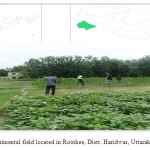 |
Figure1: Experimental field located in Roorkee, Distt. Haridwar, Uttarakhand, India Click here to View figure |
Experiment setup, data collection and laboratory analysis:
The selected agricultural field for experimental work was divided into twelve plots having size of 22m x 5m each. Four different land uses (Sugarcane, Maize, Black gram and Fallow land) were used for measuring the runoff, sediment and nutrient losses. The plots were constructed in such a manner that each land use should have three different slopes (5%, 3% and 1%). The infiltration tests were carried out in each plot by using a double ring infiltrometer for knowing the hydrologic soil group (HSG). The land preparation and crop cultivation was made properly with standard agricultural practices for achieving the objectives under rain fed agriculture. Rainfall data were measured by using ordinary type rain gauge as well as by recording type rain gauge for verification. The collection chambers of size 1m x 1m x 1m constructed at downstream side of each plot was used for the runoff collection. Each chamber was connected to the respective plot by a 3m long conveyance channel in connection with screen and multi slot divisor having five slots. The measured volume of collected surface runoff in collection tank was multiplied by 5 times to get the total volume of runoff generated by rainfall event (for past 24 hours).
Chemical Analysis:
Firstly, a portion of runoff samples was collected in a bottle followed by filtration for analyzing sediment and nutrient loss. The sediment retained after filtering the runoff sample was oven drying at 50°C for 24 hours. The soil loss was calculated by multiplying the volume of the total surface runoff with concentration of sediment measured in runoff water. Similarly, the total N was also calculated by multiplying the runoff volume with amount of concentration of total N detected in runoff water. In case of total P and total K determination, both dried samples and filtrate runoff were used for analysis. The total nutrients losses were calculated by summing the nutrient loss through runoff and through sediments.
Nitrogen (N) was determined by using micro Kjeldahl method (Jan-Åke, 2008), while phosphorus (P) and potassium (K) were measured by acid digestion method using Inductively coupled Plasma
Mass Spectrometry (ICP-MS) (Ammann, 2007).
Mean runoff coefficient determination:
The mean runoff coefficient of plot was determinate by taking the mean of all individual rainfall events runoff coefficient.

Where, Qi is the direct surface runoff for event i, Pi is the rainfall amount for event i, and n is the total number of events.
Statistical analysis:
The observed field data were analyzed using the SPSS version 20.0. Regression analyses were performed and Coefficient of determination (R2) values was calculated to show the relationships among rainfall, runoff, soil and nutrient losses. The relationship between two variables were considered statistically significant at P<0.05.
Results And Discussion
In present study, data from all experimental plots were analyzed individually in order to examine their effect on the variables being studied. The total number of rainfall-runoff events captured during the study (monsoon) period was 20 out of which only six events had produced sufficient amount of runoff to collect samples for sediment and nutrients analysis (table 1).
Rainfall-Runoff Relationship:
A simple linear regression model was tested for studying the relationship between rainfall and runoff. In present study, the relationship between rainfall and runoff for all the plots was found to be statistically significant (R2=0.675-0.928, p<0.05, n=13) (table 2). These relationships showed that the runoff increased with increase in rainfall with good positive correlations. Plot land use, slope and soil type significantly influenced runoff generation (table 1). As shown in table 1, it was found that the highest grade plot yield the highest magnitude of runoff (i.e. runoff coefficient) for a given soil type and land use. However, sugarcane plot with 5 and 1% slope was the exceptional case where higher slope could not produce higher runoff. In both the sugarcane plots infiltration rate of plot having 5% slope was higher in comparison to plot of 1% slope. Therefore, in these two plots, the effect of slope of plot is not as prominent as that of soil, and thus, it could possible that a plot of higher grade generated lesser runoff. The rainfall-runoff data from the experimental plots of various characteristics shown that for given rainfall input, the plot of sugarcane landuse with 1% slope was found to produce highest amount of runoff. Similarly, the plot of fallow land with 1% slope produced the least runoff.
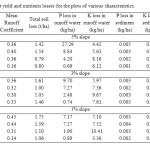 |
|
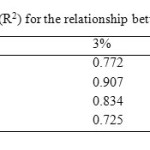 |
|
Runoff-Soil loss Relationship
Firstly, the event soil loss (t/ha) was plotted against the corresponding rainfall (mm) values. These relationships confirm the poor correlation to exists between rainfall and soil loss. The daily soil loss (t/ha) values, therefore, plotted against the corresponding runoff values (m3/ha), as shown in figs. 2(a-c). Relatively low value of R2 (0.131-0.931) associated with these relations may be noted. The soil loss from the experimental plots of various characteristics shown that for given rainfall input, on average the plots with sugarcane landuse were found to produce high amount of soil loss followed by Maize, fallow land and Blackgram.
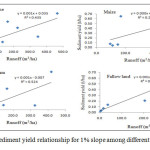 |
Figure 2(a): Runoff-sediment yield relationship for 1% slope among different land uses Click here to View figure |
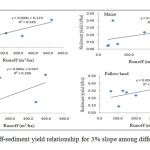 |
|
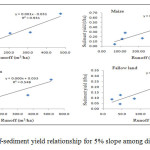 |
|
Soil loss-nutrient loss relationship:
The nutrients losses were very low in the sediment as compared to the dissolved losses (i.e. runoff water). Nutrients concentration in sediment and runoff water was found to be more during the initial stage of crop growth. The initial stage of crop growth cycle considered as the critical period in terms of soil erosion (Laflen and Tabatabai, 1984; Yoo et al., 1988).
In present study, crops were planted during the last week of May, 2013. Therefore, the critical period for current study was considered up to July, 2013, during which high amount of sediment concentration and nutrient loss was observed as compared to other period. All the three primary nutrients viz. TN, TP, TK loss (kg/ha) values were plotted against the corresponding soil loss (kg/ha) values for each experimental plot. These relationships revealed that a poor correlation to existed between nutrient and soil loss.
Seasonal rainfall, runoff, soil loss and nutrient loss:
The seasonal values of mean runoff coefficient, soil loss, and nutrient losses from the experimental plots of various characteristics are shown in table 1. The mean percentage conversion of rainfall into surface runoff was found to vary from 14% to 45%. The soil loss recorded from experimental plots of various characteristics ranged between 0.79 and 1.75 t/ha. Although, the present study is season based, however still its result can be comparable to other annual based studies as around 70% of annual precipitation occurs during monsoon season in India. Kothyari et al. (2004) reported 0.06 to 5.47 t/ha/yr soil loss from different land use systems in Central Himalayan region of India. Mishra et al. (2010) reported the soil loss as of 0.56-1.01 t/ha/yr from an agricultural soil in semi arid region of India. In addition, the work documented by Rai and Sharma (1998) and Mandal et al. (2012) reported a relatively high amount of soil loss from agricultural land use plots, but under tolerance limit in Indian Subcontinent (Bhattacharya et al., 2008). The present study revealed that the soil loss is under tolerance limit as per the soil erosion tolerance limit (2.5 to 12.5 t/ha/yr) in Indian Subcontinent (Bhattacharya et al., 2008).
As shown from table 1, the seasonal total P loss vary from 0.689 to 27.291 kg/ha and total K recorded from the experimental plots of various characteristics vary from 3.368 to 10.423 kg/ha. The loss of annual total P was 5 kg/ha reported by Rai and Sharma (1998); whereas the average annual nutrient losses reported by Mandal et al. (2012) were 10.2 kg/ha for total N, 1.0 kg/ha/yr for total P and 20.07 kg/ha/yr for total K. The total K reported in present study is in similar range as reported in literature. However, the total P reported from present study showed relatively higher variation in comparison to other studies.
Conclusions
The present study was carried out to explore the existence of relationship among rainfall, runoff, soil loss and nutrient losses from the twelve experimental plots of various characteristics located at Roorkee, Uttarakhand, India. The experimental plots were constructed to have four different land uses (sugarcane, maize, blackgram and fallow), soil type and slopes. The highest grade plot was found to yield the highest magnitude of runoff (i.e. runoff coefficient) for a given land use and soil type. The soil loss from the experimental plots of various characteristics shown that for given rainfall input, on average the plots with sugarcane land use were found to produce high amount of soil loss followed by Maize, fallow land and Blackgram. The nutrients losses were very low in the sediment as compared to the dissolved losses. Nutrients concentration in runoff water and sediment were found to be more during the critical period. The soil loss observed from the experimental plots was under tolerance limit. The seasonal loss of TP varied between 0.689 and 27.291 kg/ha and TK recorded from different plots ranged between 3.368 and 10.423 kg/ha. The land uses and land treatment greatly influenced the sediment yield as well as total nutrients losses which were lower for good canopy coverage and vice versa.
NOTATIONS
TK= Total Potassium
TN= Total Nitrogen
TP= Total Phosphorus
kg/ha/yr= Kilogram per hectare per year
t/ha= tonne per hectare
Acknowledgement
The authors are grateful to the Indian National Committee on Surface Water (INCSW) (formerly Indian National Committee on Hydrology (INCOH)), Ministry of Water resources, Govt. of India, New Delhi, for sponsoring this research.
References
- Zuazo, V. H. D., Raya, A. M. and Ruiz, J. A., Nutrient losses by runoff and sediment from the taluses of orchard terraces, Water, Air and Soil Pollution, 153, 355-373 (2004).
- Kang, S. Z., Zhang, L., Song, X. Y., Zhang, S. H., Liu, X. Z., Liang, Y. L. and Zheng, S.Q., Runoff and sediment loss response to rainfall and land use in two agricultural catchments on the Loess Plateau of China, Hydrological Processes, 15, 977-988 (2001).
- Creamer, R. E., Brennan, F., Fenton, O., Healy, M. G., Lalor, S. T. J., Lanigan, G. J., Regan, J. T. and Griffiths, B.S., Implications of the proposed soil framework directive on agricultural systems in Atlantic Europe-a review, Soil Use and Management, (26), 198-211 (2010).
- Guerra, A., The effect of organic matter content on soil erosion in simulated rainfall experiments in W. Sussex, UK, Soil Use and Management, 10, 60-64 (1994).
- Kunimatsu, T., Management and runoff of nutrients from farming land, water management technology, 27, 713-720 (1986).
- Kin-Che, L., Leung Y. F. and Yao, Q., Nutrient fluxes in the Shenchong Basin, Deqing County, South China, Catena, 29, 191-210 (1997).
- Lal, R., Soil erosion by wind and water: problems and prospects, in soil erosion research methods, Soil and Water Conservation Society, edited by R. Lal, Ankeny, IA (1994).
- Albadalejo, M. S. and Stocking, M. A., Comparative evaluation of two models in predicting storm soil loss from erosion plots in semi-arid Spain, Catena 16, 227-236 (1989).
- Soto, B., Basanta, R., Perez, R. and Diaz-Fierros, F., An experimental study of the influence of traditional slash-and-burn practices on soil erosion, Catena 24, 13-23 (1995).
- Battany, M. C., and Grismer, M. E., Rainfall runoff and erosion in Napa Valley vineyards: effects of slope, cover and surface roughness, Hydrological Processes, 14, 1289-1304 (2000).
- Girmay, G., Singh, B.R., Nyseen, J. and Borrosen, T., Runoff and sediment-associated nutrient losses under different land uses in Tigray, Northern Ethiopia, Journal of Hydrology, 376, 70-80 (2009).
- McGrath, D. A., Smith, C. K., Gholz, H. L. and Oliveria, F., Effects of land use change on soil nutrient dynamics in Amazonia, Ecosystems, 4(1), 625-645 (2001).
- Pardini, G., Gispert, M. and Dunjo, G., Runoff erosion and nutrient depletion in five Mediterranean soils of NE Spain under different land use, Science of the total environment, 309 (1-3), 213-224 (2003).
- Xing-Chang, Z., Ming-An, S., Effects of Vegetation Coverage and Management Practice on Soil Nitrogen Loss by erosion in a hilly region of the Loess Plateau in China, Acta Botanica Sinica, 45(10), 1195-1203, (2003).
- Kothyari, B. P., Verma, P. K., Joshi, B.K., and Kothyari, U.C., Rainfall-Runoff-Soil and nutrient loss relationships for plot size areas of Bhetagad watershed in Central Himalaya India, Journal of Hydrology, 293, 137-150 (2004).
- Mandal, U. K., Sharma, K. L., Prasad, J. V. N. S., Reddy, B. S., Narsimlu, B., Saikia, U.S., Adake, R.V., Yadaiah, P., Masane R. N., Venkanna K., Venkatravamma K., Satyam B., Raju B., and Srivastava N. N., Nutrient losses by Runoff and Sediment from an Agricultural Field in Semi-arid Tropical India, Indian J. Dryland Agriculture Res. and Dev., 27 (1), 01-09 (2012).
- Narayan, D. V. V., Sastry, G. and Patnaik, U. S., Watershed management, Pusa, Indian Council of Agriculture Research, New Delhi (1991).
- Rai, S. and Sharma, E., Comparative assessment of runoff characteristics under different land use patterns with in a Himalayan watershed, Hydrological processes, 12, 2235-2248 (1998).
- Singh, K. A., Impact of various land uses on soil properties of sloping hills in Sikkim, Eastern Himalaya, Indian Journal of Soil Conservation, 27(1), 70-73 (1999).
- Sharma, E., Rai, S.C. and Sharma R., Soil water and nutrient conservation in mountain farming systems: Case-study from the Sikkim Himalaya, Journal of Environmental Management, 61 (3), 123-135 (2001).
- Kumar, K., Hari Prasad, K. S. and Arora, M. K., Estimation of water cloud model vegetation parameters using a genetic algorithm. Hydrological Sciences Journal, 57(4), 776-789 (2012).
- Jan-Åke, P., Handbook for Kjeldahl Digestion: A Recent Review of the Classical Method with Improvements Developed by FOSS, FOSS, DK-3400 Hilleroed, Denmark, (2008).
- Ammann, A. A., Inductively coupled plasma mass spectrometry (ICP-MS): a versatile tool, Journal of mass spectrometry, 42, 419–427 (2007).
- Laflen, J. M. and Tabatabai, M. A., Nitrogen and phosphorus losses from corn-soybean rotations as affected by tillage practices, Trans. ASAR, 27, 58-63 (1984).
- Yoo, H. K, Touchton, J. T. and Walker, R. H., Runoff, Sediment and Nutrient Losses from Various Tillage Systems of Cotton, Soil and Tillage Research, 12, 13-24 (1988).
- Mishra, P. K., Cogle, A. L., Sharma, K. L., Smith, G. D., Rao, K. V., Freebairn, D. M., Subba Reddy, G., King, C., Korwar, G. R., Osman, M. and Venkateswarlu, B., Natural Resources Management in semi arid regions: Learning from farm and watershed level action research of ICAR-ACIAR collaborative project, Central Research Institute for Dryland Agriculture, 184 (2010).
- Bhattacharyya, P., Bhatt, V.K. and Mandal, D., Soil loss tolerance limits for planning of soil conservation measures in Shivalik-Himalayan region of India, Catena, 73, 117-124 (2008).







